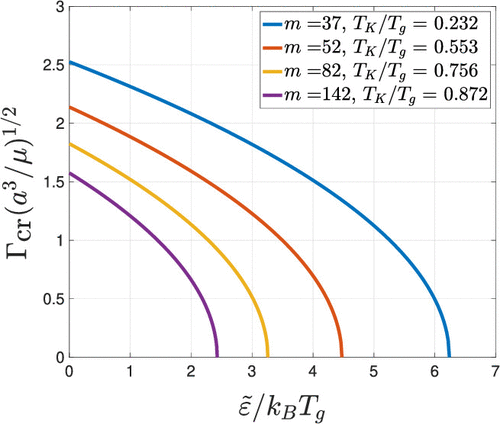当前位置:
X-MOL 学术
›
J. Phys. Chem. B
›
论文详情
Our official English website, www.x-mol.net, welcomes your
feedback! (Note: you will need to create a separate account there.)
Photon Activation of Glassy Dynamics: A Mechanism for Photoinduced Fluidization, Aging, and Information Storage in Amorphous Materials.
The Journal of Physical Chemistry B ( IF 2.8 ) Pub Date : 2020-08-28 , DOI: 10.1021/acs.jpcb.0c06515 Vassiliy Lubchenko 1 , Peter G Wolynes 2
The Journal of Physical Chemistry B ( IF 2.8 ) Pub Date : 2020-08-28 , DOI: 10.1021/acs.jpcb.0c06515 Vassiliy Lubchenko 1 , Peter G Wolynes 2
Affiliation

|
We discuss the photon activation of structural relaxations in glassy melts and frozen glasses containing molecules that can photoisomerize. The built-in stress following a photoinduced electronic transition lowers the thermal activation barrier for subsequent structural reconfiguration of the glassy matrix. We provide explicit predictions for the barrier distribution and structural relaxation spectrum as functions of the concentration of photoactivated molecules and the fragility of the material. The typical barrier decreases upon photoactivation, while the barrier distribution increases in width with increasing mole fraction of photoactive molecules and fluence, and becomes multimodal. In a frozen glass, the initial effects of photoisomerization locally facilitate the dynamics near the excited chromophores and can lead to complete fluidization at a sufficiently high fluence. Photon activation initially decreases the yield strength of the glass. Depending on the precise time course of illumination, there however emerges a spatial coexistence of softened regions with regions that, after being destabilized by illumination, have reconfigured so that they are now made of ultrastable glass or have crystallized as in a porcelain. This sequence of events, after illumination, can lead to highly stable amorphous solids, potentially approaching the Kauzmann limit. These mechanisms are at the root of optical information storage technologies in amorphous materials.
中文翻译:

玻璃态动力学的光子活化:非晶态材料中光致流化,老化和信息存储的机制。
我们讨论了玻璃状熔体和含有可光异构化分子的冷冻玻璃中结构弛豫的光子活化。光诱导电子跃迁后的内在应力降低了玻璃基体随后结构重新配置的热活化势垒。我们提供的障碍物分布和结构弛豫谱的显着预测是光活化分子浓度和材料脆性的函数。典型的势垒在光活化时降低,而势垒分布随着光敏分子的摩尔分数和注量的增加而宽度增加,并变为多峰。在冰冻的玻璃杯中 光异构化的初始作用局部促进了激发的发色团附近的动力学,并可能以足够高的通量导致完全的流化。光子活化最初会降低玻璃的屈服强度。但是,根据照明的精确时间过程,会出现软化区域的空间共存,这些区域在通过照明不稳定后已重新配置,以使它们现在由超稳定玻璃制成或像瓷器一样结晶。照明后,此事件序列可能导致高度稳定的无定形固体,可能接近考兹曼极限。这些机制是非晶材料中光学信息存储技术的根本。光子活化最初会降低玻璃的屈服强度。但是,根据照明的精确时间过程,会出现软化区域的空间共存,这些区域在通过照明不稳定后已重新配置,以使它们现在由超稳定玻璃制成或像瓷器一样结晶。照明后,此事件序列可能导致高度稳定的无定形固体,可能接近考兹曼极限。这些机制是非晶材料中光学信息存储技术的根本。光子活化最初会降低玻璃的屈服强度。但是,根据照明的精确时间进程,会出现软化区域的空间共存,这些区域在通过照明不稳定后已重新配置,以使它们现在由超稳定玻璃制成或像瓷器一样结晶。照明后,此事件序列可能导致高度稳定的无定形固体,可能接近考兹曼极限。这些机制是非晶材料中光学信息存储技术的根本。已重新配置,以使其现在由超稳定玻璃制成或已像瓷器一样结晶。照明后,此事件序列可能导致高度稳定的无定形固体,可能接近考兹曼极限。这些机制是非晶材料中光学信息存储技术的根本。已重新配置,以使其现在由超稳定玻璃制成或已像瓷器一样结晶。照明后,此事件序列可能导致高度稳定的无定形固体,可能接近考兹曼极限。这些机制是非晶材料中光学信息存储技术的根本。
更新日期:2020-09-24
中文翻译:

玻璃态动力学的光子活化:非晶态材料中光致流化,老化和信息存储的机制。
我们讨论了玻璃状熔体和含有可光异构化分子的冷冻玻璃中结构弛豫的光子活化。光诱导电子跃迁后的内在应力降低了玻璃基体随后结构重新配置的热活化势垒。我们提供的障碍物分布和结构弛豫谱的显着预测是光活化分子浓度和材料脆性的函数。典型的势垒在光活化时降低,而势垒分布随着光敏分子的摩尔分数和注量的增加而宽度增加,并变为多峰。在冰冻的玻璃杯中 光异构化的初始作用局部促进了激发的发色团附近的动力学,并可能以足够高的通量导致完全的流化。光子活化最初会降低玻璃的屈服强度。但是,根据照明的精确时间过程,会出现软化区域的空间共存,这些区域在通过照明不稳定后已重新配置,以使它们现在由超稳定玻璃制成或像瓷器一样结晶。照明后,此事件序列可能导致高度稳定的无定形固体,可能接近考兹曼极限。这些机制是非晶材料中光学信息存储技术的根本。光子活化最初会降低玻璃的屈服强度。但是,根据照明的精确时间过程,会出现软化区域的空间共存,这些区域在通过照明不稳定后已重新配置,以使它们现在由超稳定玻璃制成或像瓷器一样结晶。照明后,此事件序列可能导致高度稳定的无定形固体,可能接近考兹曼极限。这些机制是非晶材料中光学信息存储技术的根本。光子活化最初会降低玻璃的屈服强度。但是,根据照明的精确时间进程,会出现软化区域的空间共存,这些区域在通过照明不稳定后已重新配置,以使它们现在由超稳定玻璃制成或像瓷器一样结晶。照明后,此事件序列可能导致高度稳定的无定形固体,可能接近考兹曼极限。这些机制是非晶材料中光学信息存储技术的根本。已重新配置,以使其现在由超稳定玻璃制成或已像瓷器一样结晶。照明后,此事件序列可能导致高度稳定的无定形固体,可能接近考兹曼极限。这些机制是非晶材料中光学信息存储技术的根本。已重新配置,以使其现在由超稳定玻璃制成或已像瓷器一样结晶。照明后,此事件序列可能导致高度稳定的无定形固体,可能接近考兹曼极限。这些机制是非晶材料中光学信息存储技术的根本。











































 京公网安备 11010802027423号
京公网安备 11010802027423号